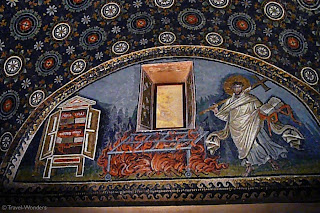
 In two hundred years of rule between the fifth and seventh centuries, the Byzantines left their crowning glory with a dazzling array of Christian mosaics in the restful town of Ravenna on Italy’s east coast. Without the crowds that infest the travel wonders of Rome, Florence, Pisa, Siena, Venice and the Cinque Terre, Ravenna makes for a superb single travel day wandering between the World heritage-listed cathedral, churches and monuments to admire the extraordinary artistry created in tiles.
In two hundred years of rule between the fifth and seventh centuries, the Byzantines left their crowning glory with a dazzling array of Christian mosaics in the restful town of Ravenna on Italy’s east coast. Without the crowds that infest the travel wonders of Rome, Florence, Pisa, Siena, Venice and the Cinque Terre, Ravenna makes for a superb single travel day wandering between the World heritage-listed cathedral, churches and monuments to admire the extraordinary artistry created in tiles.  At first sight, Ravenna appears to be an historic town of buildings with dull exteriors. It is only when you wander inside these churches and museums that you discover interiors filled with a breathtaking kaleidoscope of glistening mosaics. Most of the sights are central and a single tickets offers entrance into several buildings making visiting hassle-free.
At first sight, Ravenna appears to be an historic town of buildings with dull exteriors. It is only when you wander inside these churches and museums that you discover interiors filled with a breathtaking kaleidoscope of glistening mosaics. Most of the sights are central and a single tickets offers entrance into several buildings making visiting hassle-free. While much of Italy stands adorned with exceptional frescoes, the mosaics of Ravenna create a different feeling with their sparkle when they catch the natural light. Furthermore, unlike the magnificent frescoes, the tiles do not fade with age, ensuring they sparkle today with the same breathtaking majesty, as the populace would have enjoyed around 1500 years ago. The effort by the artisans to carefully cut and place tiny pieces of glass, marble and stones into such massive spiritual images must have been painstaking work.
While much of Italy stands adorned with exceptional frescoes, the mosaics of Ravenna create a different feeling with their sparkle when they catch the natural light. Furthermore, unlike the magnificent frescoes, the tiles do not fade with age, ensuring they sparkle today with the same breathtaking majesty, as the populace would have enjoyed around 1500 years ago. The effort by the artisans to carefully cut and place tiny pieces of glass, marble and stones into such massive spiritual images must have been painstaking work. The most remarkable of all is Basilica of St Vitalus (interior and exterior photos above). A dull octagonal building of darkish yellow stone from the outside gives way to a glowing apse and choir area with natural light streaming through the tiny windows highlighting the dazzling green, blue and gold mosaics of familiar biblical tales. The stunning central ceiling shows Christ at the centre of five figures including St Vitale (top photo) while to give an example of the biblical detail, the chancel photo shows Abel’s sacrifice of a lamb, Moses tending sheep and side images of Matthew and Mark with the lion (Luke and John are on the other side). The arch at the entrance to this area is adorned with Christ and the twelve apostles.
The most remarkable of all is Basilica of St Vitalus (interior and exterior photos above). A dull octagonal building of darkish yellow stone from the outside gives way to a glowing apse and choir area with natural light streaming through the tiny windows highlighting the dazzling green, blue and gold mosaics of familiar biblical tales. The stunning central ceiling shows Christ at the centre of five figures including St Vitale (top photo) while to give an example of the biblical detail, the chancel photo shows Abel’s sacrifice of a lamb, Moses tending sheep and side images of Matthew and Mark with the lion (Luke and John are on the other side). The arch at the entrance to this area is adorned with Christ and the twelve apostles.  Next door to the basilica is the Tomb of Gallia Placidia. Being only a small space inside, avoid a tour group to fully appreciate this building. The translucent light from the alabaster windows lights a magical luminescent deep blue ceiling of golden stars and flowers. One striking image shows a saint next to a burning grill and a cupboard containing the four gospels.
Next door to the basilica is the Tomb of Gallia Placidia. Being only a small space inside, avoid a tour group to fully appreciate this building. The translucent light from the alabaster windows lights a magical luminescent deep blue ceiling of golden stars and flowers. One striking image shows a saint next to a burning grill and a cupboard containing the four gospels.
The tour of Ravenna continues in a second post.
Tuesday, July 7, 2009
Touring the Mosaic City (Ravenna, Italy) - Part One
Labels:
Europe,
Italy,
travel wonders,
UNESCO
Subscribe to:
Post Comments (Atom)


4 comments:
what an exotic and historical country.. You share the traveling greatly, love to read. Thank you.
@johnathan: Thank you.
These beautiful photos have added another city to my "travel list." Thanks.
Mark - as usual, I very much love your posts. With Ravenna, I am intrigued about the mosaics, all in Byzantine style, although the Byzantines haven't actually (re)conquered the city until 540, from what I have read. Some of the churches, however, including the Mausoleum of Gallia Placida, are dating back to the mid 400s. Still working to solve this.
Your posts are so interesting, but I have to admit, I enjoy the photos as much as the text: exquisite! I would like to spend as much time promoting your site as I would my own :)
Post a Comment